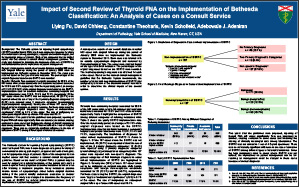Impact of Second Review of Thyroid FNA on the Implementation of Bethesda Classification: An Analysis of Cases on a Consult Service
Liying Fu, David Chhieng, Constantine Theoharis, Kevin Schofield, Adebowale J. Adeniran
Department of Pathology, Yale School of Medicine, New Haven, CT
ABSTRACT
Background: The Bethesda system for reporting thyroid cytopathology (BSRTC) stratifies thyroid FNAs into 6 main diagnostic categories for clarity of communication among pathologists, surgeons and endocrinologists, and for appropriate triage of patients. Each of the categories has an implied cancer risk that ensures a rational clinical management guideline. This study was designed to determine the frequency of the use of BSRTC by referral laboratories and its implications on patient management.
Design: A retrospective search of our consult database revealed 693 cases with surgical follow-up during the period of January 2008 when we implemented the Bethesda system to December 2011. The cases were stratified based on the type of referral institution. The percentages of the original diagnoses based on the BSRTC were recorded.
Results: Referrals from community hospitals accounted for 80.8% of the 693 cases while private laboratories and academic institutions accounted for 15.6% and 3.6%, respectively. Over the 4-year study period, an average of 73.15% (SD 3.0%) of the original diagnoses were based on the BSRTC. Implementation rates for academic institutions, community hospitals and private laboratories were 72.0%, 73.4% and 71.3%, respectively. Of the 187 cases where the BSRTC was not implemented, 48 (25.7%) were reported without the use of any of the 6 primary diagnostic categories; 12 (6.4%) were reported using 2 diagnostic categories (overwhelmingly atypical/suspicious categories). Seventy-one of these 187 cases (38%) turned out to be malignant on surgical resection. For those cases using the BSRTC, the original diagnoses were “atypia of undetermined significance” (AUS) in 6.1% of the cases. The rate of malignancy on subsequent surgical follow up of these AUS cases was 58.1%.
Conclusions: Five years after the guidelines were proposed, reporting of thyroid FNA still varies significantly from one laboratory to another, creating confusion in some cases and hindering the sharing of clinically meaningful data among laboratories. The BSRTC was not utilized in 1 out of 4 thyroid specimens. There was no statistically significant difference in the rate of utilization of BSRTC among different types of referral laboratories.
©2013 Yale Department of Pathology. All rights reserved.
Any redistribution or reproduction of part or all of the contents in any form is prohibited. You may not, except with express written permission of the author or the Department of Pathology, distribute or commercially exploit the content, nor may you transmit it or store it in any other website or other form of electronic retrieval system, including use for educational purposes.
